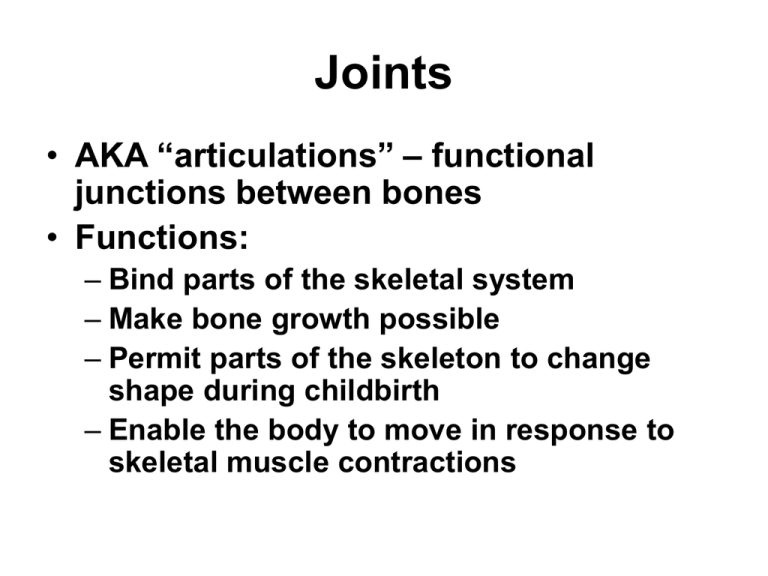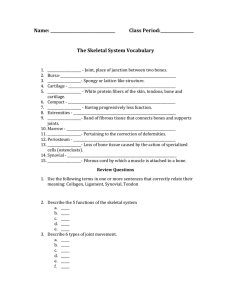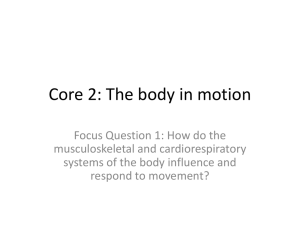Joints and Joint Movements
advertisement

Joints • AKA “articulations” – functional junctions between bones • Functions: – Bind parts of the skeletal system – Make bone growth possible – Permit parts of the skeleton to change shape during childbirth – Enable the body to move in response to skeletal muscle contractions Types of Joints • Fibrous joints • Cartilaginous joints • Synovial joints – Ball-and-socket joints – Condyloid joint – Gliding joints – Hinge joint – Pivot joint – Saddle joint Fibrous Joints • Between bones that closely contact each other • Bones are joined by thin layer of dense connective tissue • No big movement at these joints • Where do you think they would be found? Cartilaginous Joints • Bones connected by hyaline cartilage (fibrocartilage) • Limited movement • Examples: intervertebral discs, symphysis pubis, rib 1 at the sternum Synovial Joint • Free movement • Articular ends of bones are covered with hyaline cartilage (articular cartilage). • Bones are held together with a surrounding, tubular capsule (joint capsule) of dense connective tissue. – Outer layer of ligaments – Inner lining of synovial membrane, which secretes synovial fluid that lubricates the Synovial Joint, continued….. • Some contain shock-absorbing pads of fibrocartilage, called menisci (meniscus, sing.) between articulating surfaces. • Some have bursae, fluid-filled sacs which are lined with synovial membranes. (Bursae are commonly located between the skin and the underlying bony prominence.) Types of Synovial Joints 1. Ball-and-socket joint --- allows for widest range of motion (Examples:????) 2. Condyloid joint – oval-shaped condyle of one bone fits into elliptical cavity of another – No rotation movement – EX: b/t phalanges and metacarpals 3. Gliding joint – Articulating surfaces are nearly flat – Allow sliding and twisting movement Types of Synovial Joints, continued….. 4. Hinge joint – Convex surface of one joint fits into concave surface of another – Resembles hinged door, allowing movement in one plane only – Examples: ????? Types of Synovial Joints, continued….. 5. Pivot joint – Cylindrical surface of one bone rotates within ring formed of bone and ligament – Movement is only rotation around a central axis – Example: Joint b/t proximal ends of radius and ulna 6. Saddle joint – Between bones with both convex and concave regions – Allows for variety of movement – Example: Joint b/t metacarpal and carpal of thumb • • Which metacarpal is this? What is the name of this carpal bone???? Types of Joint Movement 1. Flexion – bending 2. Extension – straightening 3. Dorsiflexion – bending foot toward shin 4. Plantar flexion – bending foot toward sole 5. Hyperextension – extension BEYOND anatomical position 6. Abduction – away from midline of Types of Joint Movement, continued….. 8. Rotation – moving around an axis 9. Circumduction – moving a part so its END follows a circular path 10. Pronation – turning hand posteriorly 11. Supination – turning hand anteriorly 12. Eversion – turning foot so sole faces laterally 13. Inversion – turning sole medially 14. Retraction – moving a part backward Types of Joint Movement, continued….. 16. Elevation – raising a part 17. Depression – lowering a part







